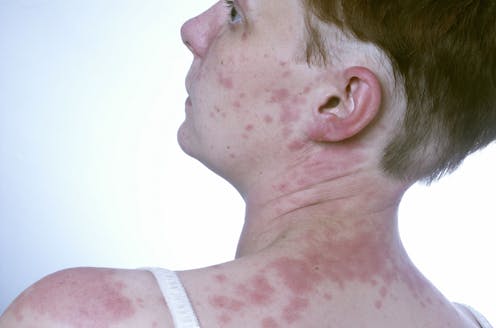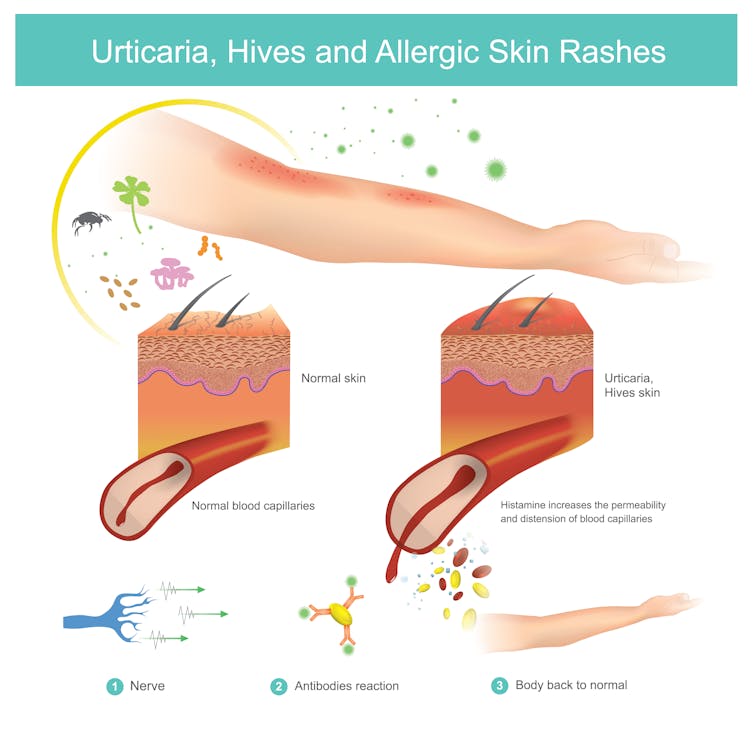
Every year, about 20% of Americans will get hives – those itchy, red bumps or welts that can appear after a day in the garden, taking medication, being bitten by a bug or for no apparent reason at all. Patricia A. MacCulloch is a nurse practitioner and professor of nursing who teaches about hives, among many other things. She offers some insight into this annoying condition that can sometimes be a sign of a life-threatening emergency.
What are hives and what causes them?
Hives are a term used to describe a medical condition known as urticaria, a skin disorder that occurs when the body’s immune system responds to an allergic threat.
Hives can occur at any age, and the appearance of hives can vary with skin color. If you have brown skin, hives are often the same color as your skin or slightly darker or lighter than your natural skin color. People who have light complexions will have pink- and red-colored hives as a result of the allergic reaction. Hives can itch, burn and sting and often feel warm to the touch. Hives can also result in blanching, whereby pressing on the hive will cause the discoloration to disappear and then return immediately when the pressure is lifted. Hives may stay, spread or emerge on another part of the skin.
Hives can occur for a variety of reasons including but not limited to certain foods, medications, plants, pollen, animal dander, insect bites and chemicals found in the garden like pesticides. It’s also possible for people to experience hives related to emotional stress, as a result of wearing tight clothing when exercising or as a result of illnesses or infection.

Why are hives bumpy and itchy?
Merriam-Webster defines a hive as “a place swarming with activity”. In my professional nursing practice, I share this definition and analogy with my teaching patients and students. Hives are the body’s immune system “swarming with activity” while attempting to manage an attack from an allergen, which is a substance that can trigger an allergic reaction. Whether the allergen is encountered directly on the skin surface – as is the case with a latex allergy – or ingested in the form of a food or medication, the body’s immune response includes the activation of histamines.
Histamines are chemicals produced by the body’s white blood cells that fight allergens. Contact with an allergen provokes the immune system to disperse histamine into the blood. This will result in the enlargement of blood vessels near the skin’s surface, causing redness, swelling and itching. The body’s histamine response is attempting to dilute the offending allergen.
How long do hives last?
Hives can occur and disappear within a 24-hour period or last for days to weeks, and they may recur based on future allergic exposure and immune response. Hives lasting more than six weeks are considered chronic. While hives are common, it is important to investigate the causes and consider the associated risks.
In some instances, hives are an early symptom of a more severe immune response known as anaphylaxis, which is a medical emergency. Anaphylaxis is a potentially life-threatening allergic reaction that results in a rapid yet weak pulse, a significant drop in blood pressure and a tightening of the airway, affecting breathing. Common immune system triggers associated with hives and anaphylaxis include foods such as nuts, medications like antibiotics and blood pressure lowering agents, insect venom from bees and or mosquitoes and allergic reactions from latex materials – just to name a few.
If you develop hives, you should contact your primary health care provider, who can gather a comprehensive health history and perform a physical examination. Once the allergic trigger is identified, you can make efforts to reduce future exposure.
What are the main treatments for hives?
Antihistamines are a type of over-the-counter medication that attempt to manage the symptoms of itching and mild swelling. Antihistamines like loratadine (Claritin) or diphenhydramine (Benadryl) can be taken by mouth or applied directly on the skin surface. A cool moist compress can provide comfort and reduce swelling. Additional treatment may include oral and topical steroids, a more potent anti-inflammatory agent to decrease the body’s inflammatory response and manage the allergic symptoms.
If you or someone you know is experiencing hives, it is important to have the symptoms discussed with a health care provider to determine the cause so that future allergic reaction risk and injury can be reduced.
Patricia A. MacCulloch does not work for, consult, own shares in or receive funding from any company or organisation that would benefit from this article, and has disclosed no relevant affiliations beyond their academic appointment.
This article was originally published on The Conversation. Read the original article.







